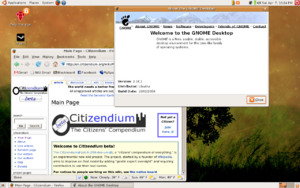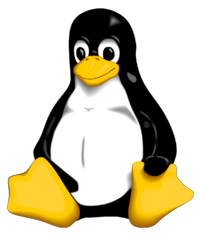Linux (operating system)
| Linux |

|
| The GNOME desktop on Ubuntu Linux 6.10 |
| Website: http://www.linux.org |
| Developer: The Open Source community |
| OS family: Unix-like |
| Source model: Open source |
Latest stable release:[1]
|
| Supported platforms: x86, x86-64, ia64, DEC Alpha, Motorola 68k, SUN Sparc, ARM, PowerPC |
| Kernel type: Monolithic kernel |
| Default user interface (most distros): GUI |
| License: GNU General Public License |
| Working state: Current |

Linux is the most successful open-source computer operating system in the world. Although it began life in 1991 as just a hobby project of a young Finnish college student, Linus Torvalds, it today enjoys a devoted following among a global community of users and developers. Once just a single release that Torvald intended as a free alternative to the proprietary UNIX system, Linux is today available in seemingly innumerable varieties. Called "distributions", they are available for nearly every variety of computer application imaginable, from top security databases of governmental agencies to the everyday computing needs of a growing family. One one hand, Linux can provide a very user-command dependent experience nearly identical to the much older Unix operating system, while on the other, it can offer the same features otherwise found only in proprietary operating systems like Windows and Macintosh. It is also very flexible — it can run on a wide variety of hardware platforms, from traditional desktop and workstation platforms such as Intel i386, AMD64 and SPARC, to mobile platforms such as ARM and Palm.[2][3]
Torvalds never intended his hobby-project to gain the global attention it has. The success Linux has experienced since its small beginnings is due in large part to the fact that Torvalds released it to the public domain — Linux can be obtained, used, and most importantly developed upon, for free by anyone anywhere. Because of this open availability, some commercial software companies have created "supported distributions" of Linux, which they offer alongside user support and guarantees of reliability. Customers of a supported version of Linux, such as Red Hat and a variety of others, pay for the peace-of-mind that comes from knowing that their needs will be supported if problems arise. Although Linux has achieved only moderate market success as a single-user desktop, it's success as a server[4] have been especially strong.
Origins
Before Torvalds began the Linux kernel project, the only low-cost, stable, Unix system developed for IBM-compatible PCs was a closed source system called 'Minix', developed by a professor named Andrew Tanenbaum. In 1984, Dr. Richard Stallman founded the landmark Free Software Foundation, a non-profit organization, in which work was done throughout the late 1980's towards creating a free Unix-like operating system. The new software was to be called the GNU[5] system, which is a recursive acronym for GNU's Not Unix. The GNU project produced highly successful tools, including the GNU C compiler, GNU debugger, and the Emacs text editor. However, the project still lacked a kernel for its new operating system. When Linux came along, and despite the fact that Torvalds did not believe that Linux could be ported easily to system architectures besides the i386, the GNU developers adopted it and combined their tools with it. They created a full-fledged operating system with good tools. Stallman's Free Software Foundation was the first open source software project, and Linux became its poster child.
The name 'Linux' was created by combining Linus with the "x" in Unix. Torvalds originally intended to call the project Freax, for Free and Freak, with the "x" denoting that it is Unix-like, but after one of his colleagues named the system's FTP directory after him, the name stuck.[6] Linux is pronounced like 'Minix' - that is, "'li' is pronounced with a short [ee] sound: compare prInt, mInImal etc.'nux' is also short, non-diphtong, like in pUt."[6]
The GNU Project members decided to call 'Linux' GNU/Linux, in order to attribute credit to those who worked hard at creating the tools that the Linux kernel runs. Torvalds, however, has made no effort to hide his thoughts towards this naming convention, saying that "calling Linux in general just 'GNU/Linux' I think is ridiculous."[7] By most in the community and officially, the name remains simply 'Linux'.
Marketplace successes and struggles
Linux is typically used either as a server (accessed remotely over a network by multiple users simultaneously), as a single-user desktop, or in some cases, filling both roles at once. When used as a server, typically Linux may fill as many differet roles, such as a web server, database server, file server, etc. The popularity of the Apache web server was one of the biggest breakthroughs in the open source community. Due to the fact that the developer community for the Unix-like platforms has been considerably larger than that of the other platforms Apache supports, many companies rely on Linux to host their websites. Among the chief reasons for them to switch at the time of Apache's first release was the ability to host more than one website on the same computer. Other large reasons it has excelled in the server market include that it is stable, fast, and generally costs less to maintain (both software and hardware) than other server platforms.
Linux has been somewhat less successful in the marketplace when used as a desktop. One reason is that the open source community has not standardized on a user interface for the desktop, but rather, different distributions either offer a choice of desktop environments, or focus on a specific one. A Linux computer can be configured to run one of several desktop environments, the most popular being GNOME and KDE. This means that a computer user cannot depend on any two Linux computers being identical to use. Despite this lack of standardization (and increased learning curve due to differences in design), some companies have turned to using Linux citing reduced cost compared to proprietary operating systems, especially Microsoft Windows.
More recently, numerous big names in commercial software have signed on to Linux support, most notably IBM and HP. Popular computer manufacturer Dell has recently announced they will offer computers with a desktop version of Linux preinstalled including bundled support, based on customer demand.[8][9]
Another platform that Linux has made inroads on is the mobile platform of PDAs and cell phones. Linux is a popular choice on this emerging platform due to its openness and flexibility.[3][2] Also notable is the GP2X, which is a mobile gaming platform similiar to Sony's PSP that is based solely on Linux, running on the ARM platform.[10]
Applications running on Linux
Aside from the GNU project's applications, Linux is capable of running many applications of all natures, from games and graphic editors to Integrated Development Environments and web servers. Among the most commonly used applications are The GIMP photo editing tool, which is commonly referred to as a free alternative to Photoshop, Firefox, a feature-complete, tabbed web browser, and OpenOffice, which is a free, full-featured alternative to the Microsoft Office suite. The GIMP, Firefox and OpenOffice are all cross-platform as well, meaning they run on Microsoft Windows and Mac OS X.
Unlike Microsoft Windows NT, Linux itself is not a graphical system. Instead, Linux relies on a graphical layer to output bitmap images. The most common application for this is called X.org, commonly referred to as just X. X.org is a very minimal program that purposely does as little as possible. Users do not normally see it, but the results of its work. X.org serves as a layer between the kernel and the desktop environment or window manager. Window managers, like Openbox or wmii, are only able to manage windows and desktops, while desktop environments, such as GNOME, KDE and Xfce, provide advanced graphical functionality, such as the ability to process text, organize photos or chat online.
Many applications designed only for Windows can be run through an interpreter called Wine, which is a recursive acronym for Wine is not an Emulator. While far from perfect (particularity in compatibility with DirectX), this project can successfully run many top-notch applications, such as Adobe Shockwave, Steam, and DVDShrink. Other commercial interpreters exist as well, such as CrossOver and Cedega, specially designed for running games. These applications are forks of Wine, hacked to support a list of various programs that the version of Wine they were based on did not.
References
- ↑ "Top 10 Distributions". Retrieved on 2007-04-09.
- ↑ 2.0 2.1 "Consortium tackles Linux mobile phone standards" (Retreived 11-April-2007).
- ↑ 3.0 3.1 "Mobile technology companies plan joint Linux platform" (Retreived 11-April-2007).
- ↑ A server is a computer that can be accessed remotely over a network by multiple users simultaneously
- ↑ About the GNU Project (Retreived 06 April 2007).
- ↑ 6.0 6.1 USENET post on Linux naming (Retreived 06 April 2007).
- ↑ The "GNU/Linux" and "Linux" Controversy (Retreived 06 April 2007).
- ↑ "Here Come the Dell Linux Desktops" (Retreived 11-April-2007).
- ↑ "Dell gives desktop Linux its full attention" (Retreived 11-April-2007).
- ↑ "GP2X Official Site" (Retreived 11-April-2007).
